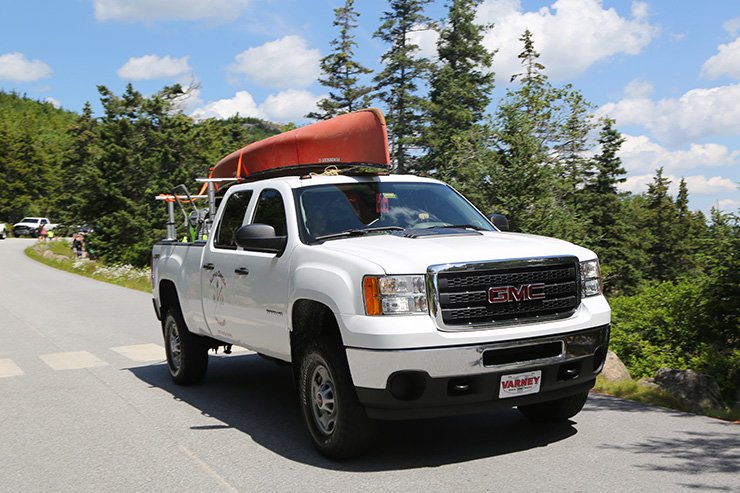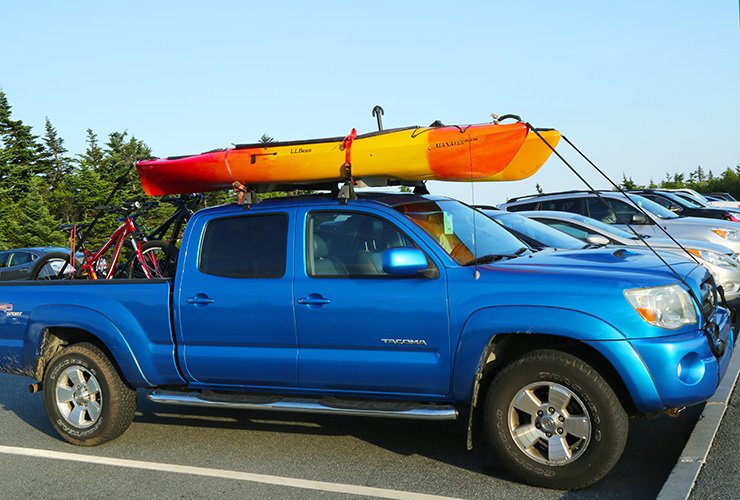If you need to transport a kayak in a truck, but your truck bed is shorter than your yak, don’t worry. You may still be able to transport your kayak in your truck – depending on how much it hangs out of the back.
So how far can a kayak hang out of a truck?
While this may seem like a small detail – ensuring your kayak overhang stays within legal limits is important for both your safety and the safety of other drivers. It can be very easy to misjudge the distance that your kayak hangs out of your truck.
The law surrounding maximum overhang is also a little bit confusing – there’s a federal law that acts as a baseline but some states make their own additions to these guidelines.
Key Takeaways
- You can transport a kayak in a truck if it doesn’t overhang more than 4 feet behind and 3 feet in front of your vehicle, according to the federal 3-4-4 rule.
- You should use flags or LED lights to mark your kayak during the day or night, respectively, to make it visible and safe for other drivers.
- Check the Department of Transportation website for each state you travel through, as some states have different rules for overhang limits and may require a permit.
- You can use a truck bed extender or a truck roof rack too if the bed of your truck doesn’t quite have the space to fit a kayak.
- You should follow the laws and regulations for transporting kayaks in trucks to avoid accidents, fines, or damage to your vehicle or kayak.
Your Kayak Can Hang Out of Your Truck 3 Feet in Front and 4 Feet Behind
The quick answer to “how far can a kayak hang out of a truck” is 4 feet out from the rear bumper and 3 feet out from the front bumper – as long as you don’t exceed this you have nothing to worry about.
However, these guidelines aren’t necessarily hard limits on how far you kayak can hang. Not all kayaks are created equal and a longer kayak may go over the overhang limit. This guide will cover what you should do if you happen to break the overhang limit later on.
The 3-4-4 Federal Law Guidelines
If in doubt about how far out your kayak can hang – remember the 3-4-4 rule. This is the federal limit and it stands for 3 feet in front, 4 inches to the sides, and 4 feet behind.
These rules have been set down to keep you and other drivers safe – if your kayak goes to far over these limits it can be difficult for other drivers to judge just how far out the kayak reaches. This makes collisions and accidents more likely.

What if Your Kayak Exceeds the Guidelines?
You do have options if your kayak goes beyond the limits of the 3-4-4 rule. There is such a thing as a legal overhang limit – which means your kayak can break the 3-4-4 rule but only up to a certain point. How much your kayak can extend past the legal limit for overhang depends on which state you’re located in.
Using Flags and Lights To Mark Your Kayak
During the day, you can use flags to mark up your kayak – this helps any drivers behind you judge distance properly and can also help make clear that they should stay back a little more from your vehicle as the load on your truck can potentially be hazardous.
Most of the time you should use orange and red warning flags. You can also use illuminated marker lamps.
Use the flags during the day and the LED-based marker lamps if you’re driving at night.
If you’re transporting multiple kayaks on your truck you’ll want to use separate flags for each kayak – tying them to the end so they are clearly visible to any drivers behind you.
How Far Can a Kayak Hang Out of a Truck: State Guidelines
Some states follow the federal 3-4-4 guidelines when it comes to hauling an overhanging load or transporting kayaks, but there are other states that have their own rules. The section below will cover separate states and what they regard as fair overhang limits.
Some states view kayaks as the same as any other vessel or cargo and other states have separate rules for kayaks. Check the Department of Transportation website for your particular state to check what the guidelines are.
The states not mentioned in the table below adopt the 3-4-4 guidelines as their limits. Also, check that your state doesn’t need a permit if your kayak does go over the overhang distance (some states tell you to just mark the kayak with flags and others also require a permit).
| State | Overhang Distance |
| Alabama | 4 feet from the rear, 5 feet from the front |
| Alaska | 4 feet from the rear, 3 feet from the front, 12 feet maximum width. If you overhang by over 10 feet you must carry an “oversized load” sign |
| Arizona | 6 feet from the rear, 3 feet from the front. Note: If your kayak overhangs more than this and you mark it with a red flag and lights you’re still violating the law in Arizona |
| California | Follows the 3-4-4 Rule but allows overhang of up to 10 feet (depending on the size of the vehicle). |
| Colorado | 10 feet from the rear (maximum), 4 feet from the front. You can’t extend beyond this limit |
| Connecticut | 4 feet from the rear, 3 feet from the front, 6 inches from the sides. Note: There’s no overhang limit in Connecticut as long as you mark up your kayak properly |
| Delaware | 6 feet from the rear, 4 feet from the front |
| Florida | 9 feet from the rear, 3 feet from the front |
| Hawaii | 10 feet from the rear, 3 feet from the front |
| Idaho | 10 feet from the rear, 4 feet from the front, 6 inches from the sides |
| Kansas | 3 feet from the front, 4 feet from the rear. Kansas is flexible with overhang as long as your vehicle doesn’t exceed 85 feet in length |
| Kentucky | 5 feet from the rear, 3 feet from the front |
| Louisiana | 8 feet from the rear, 3 feet from the front |
| Maine | 6 feet from the rear, 4 feet from the front |
| Maryland | 6 feet from the rear, 3 feet from the front |
| Michigan | Unrestricted overhang as long as you stay within the length of your vehicle. If you go over 4 feet from the front or rear then you must mark your kayak with a red flag |
| Minnesota | 4 feet from the rear, 3 feet from the front, 6 inches from the sides |
| Mississippi | 15 feet from the rear, 3 feet from the front |
| Nebraska | Any overhang so long as you don’t exceed the legal length of your truck |
| Nevada | 10 feet from the rear, 10 feet from the front |
| New Mexico | 7 feet from the rear, 3 feet from the front |
| North Dakota | 10 feet from the rear, 10 feet from the front |
| Oregon | 5 feet from the rear, 4 feet from the front |
| Pennsylvania | 6 feet from the rear, 3 feet from the front |
| Rhode Island | 6 feet from the rear, 3 feet from the front (the same as Pennsylvania) |
| South Carolina | 6 feet from the rear, 3 feet from the front |
| Vermont | 6 feet from the rear, 3 feet from the front |
| Washington | 15 feet from the rear, 3 feet from the rear |
| West Virginia | 6 feet from the rear, 3 feet from the front |
| Wyoming | 4 feet from the rear, 4 feet from the front |
While state by state laws around overhanging cargo or kayaks do vary considerably, keeping the 3-4-4 rule in mind can help to keep things much simpler.
If you stick to the 3-4-4 rule then it doesn’t matter where you are in the US, your kayak isn’t overhanging by too much. You can use a brightly colored flag (these are usually red or orange and can be bought cheaply from hardware stores – usually referred to as a warning flag) to mark each kayak you’re transporting during the day.
At night, ensure your kayak is properly marked by an illuminating LED light, these can also be bought cheaply from most hardware stores.

What to Do If Your Kayak Overhangs Too Much
It’s very easy to have an overhang that ends up over the maximum limit, especially if you’re in an SUV or smaller pickup truck. The type of kayak you’re transporting will also make a difference. For example, tandem kayaks can easily reach lengths of 13 feet, and touring kayaks can go up 17 feet!
There are some options if your truck’s bed doesn’t quite have the space to fit a kayak within legal limits.
Use a Truck Bed Extender
A truck bed extender is an attachment that usually works with the tailgate down and is an option if your kayak doesn’t quite fit into the back of your truck. Just bear in mind that a truck bed extender may not count as the rear of your truck when it comes to how far your kayak can legally overhang.
Use a Truck Roof Rack
Just like most cars, you can purchase a roof rack for your truck, your best bet is to find a roof rack dedicated to kayaks.
Even if you’re transporting multiple kayaks you’re unlikely to extend beyond the front and rear legal overhang limits in most states. You might need to be a bit cautious about overextending on the sides if you are transporting multiple fishing kayaks, for example.
Conclusion
When it comes to understanding how far a kayak can hang out of a truck there are some basic rules and regulations to take into consideration.
Understanding the 3-4-4 federal guidelines and remembering to mark up any kayaks you’re transporting properly are the most important things to remember.
Thank you for reading, please like, comment, or share if you found the information here useful.

